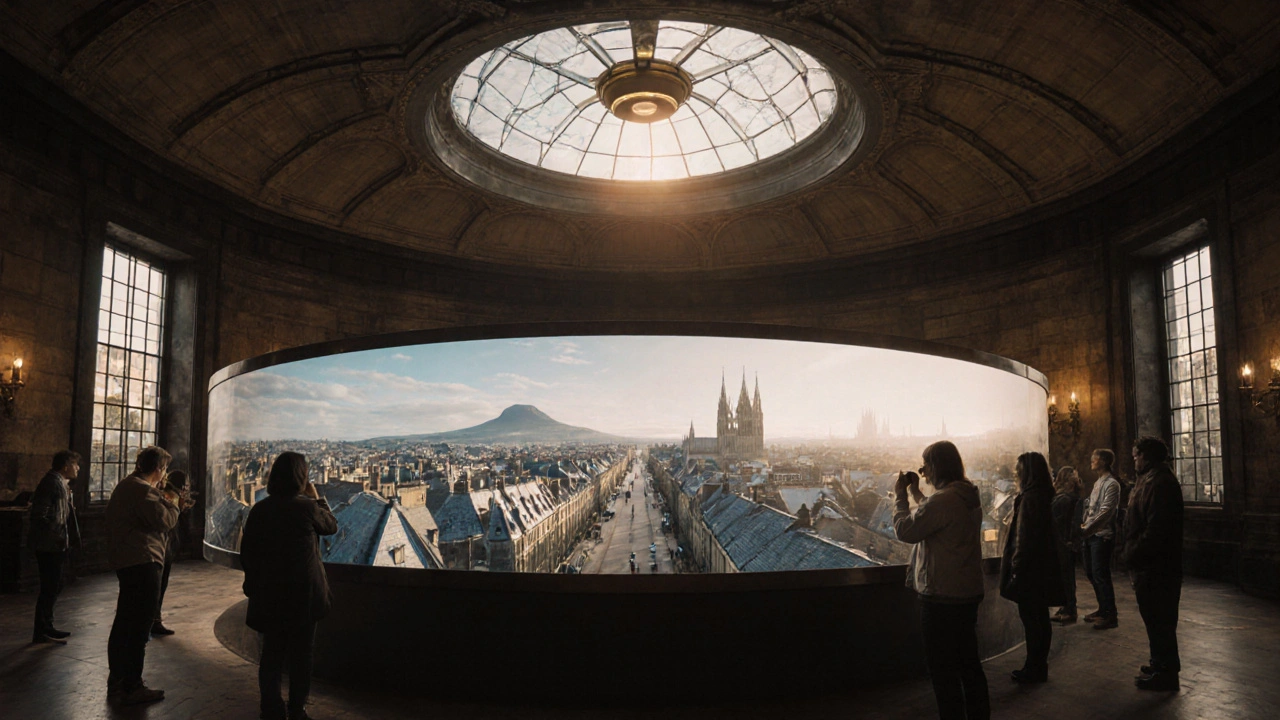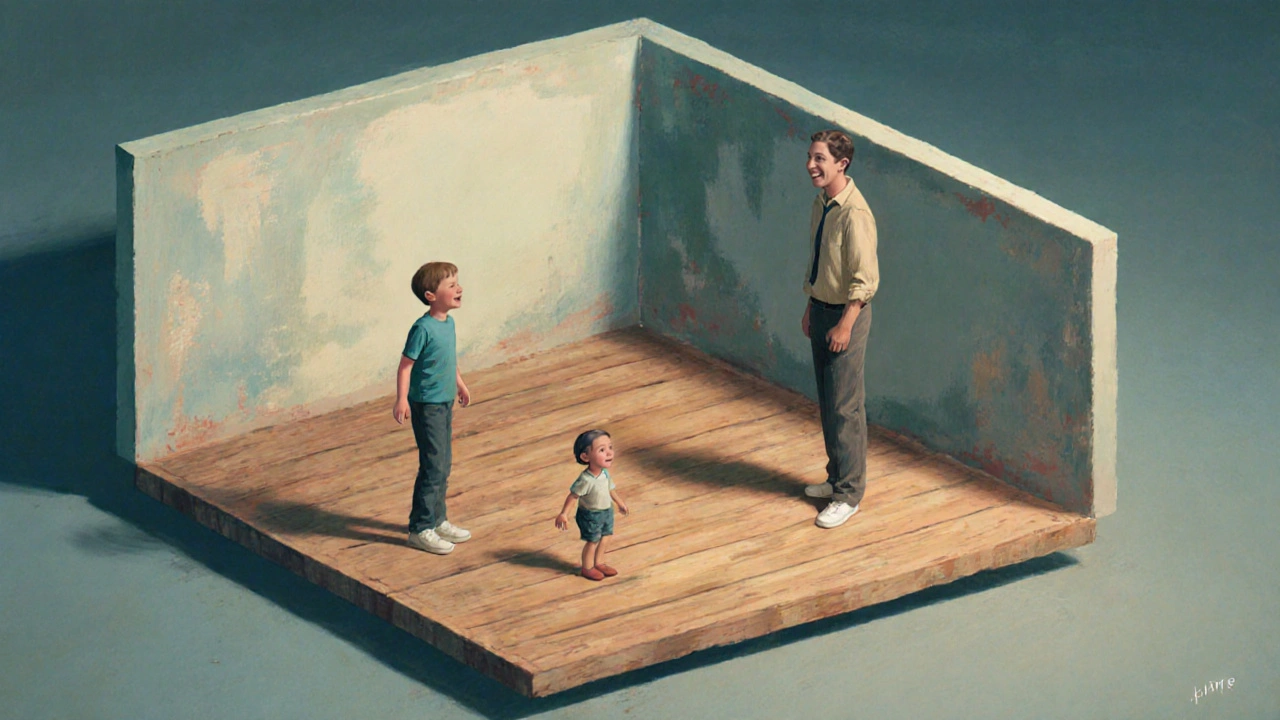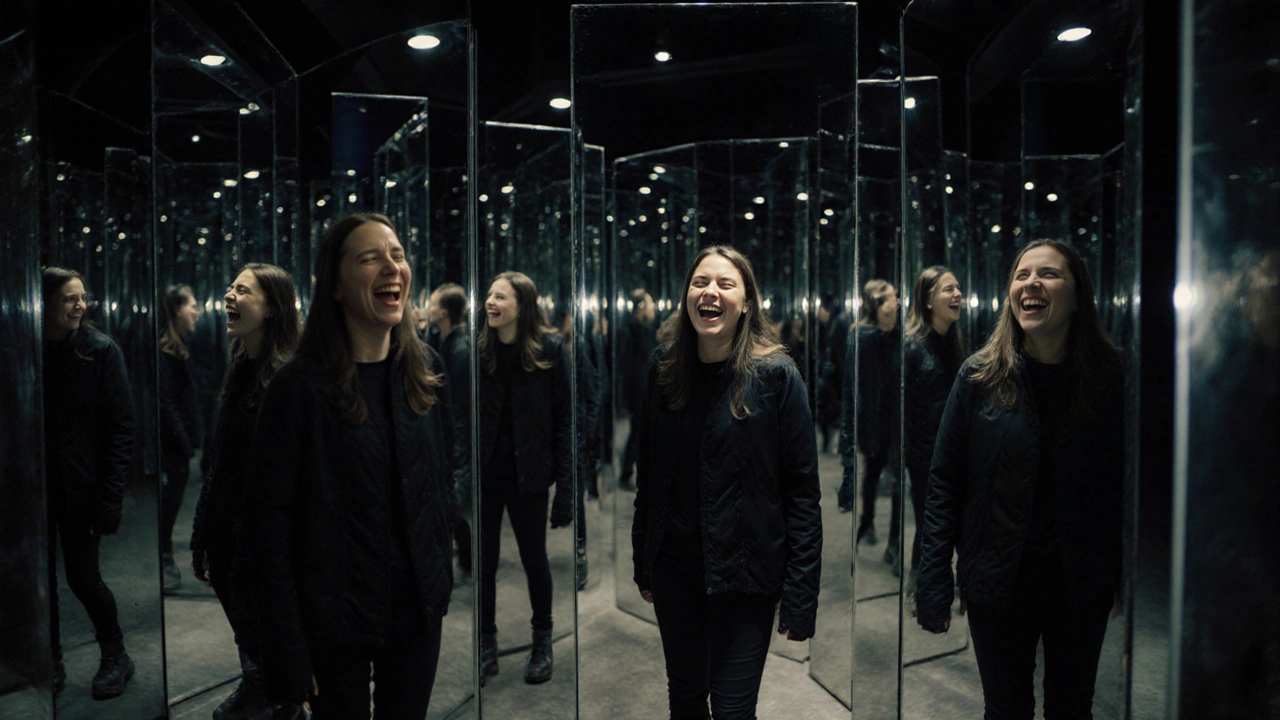
Standing on the Royal Mile in Edinburgh, you might think you’ve seen it all-castles, cobblestones, and bagpipers. But step inside the Camera Obscura and World of Illusions, and the world turns upside down. Literally. The ceiling above you flips the skyline of Edinburgh into a live, moving painting. No screens. No filters. Just light, lenses, and centuries-old science. This isn’t just another tourist trap. It’s one of the city’s oldest and most mind-bending attractions, and it’s been pulling in visitors since 1853.
How the Camera Obscura Works (Without the Jargon)
Think of it like a giant pinhole camera. Sunlight streams through a small opening in the roof, hits a curved mirror, and projects the outside world onto a circular viewing table below. The image is real-time. Cars move. Clouds drift. People walk by-all in perfect, silent detail. You don’t need to know anything about optics to get it. Just stand there, watch a bus turn a corner, and realize you’re seeing the city as it is, not as a photo. It’s the same principle Galileo used to study the sun, but here, it’s turned into a public spectacle.
What makes this different from a regular window? The mirror bends the image so it’s upright and life-sized. You’re not looking through glass-you’re standing inside the lens. And because the building sits on a hill, the view stretches from Arthur’s Seat to the Firth of Forth. On a clear day, you can spot the Forth Bridge like a silver thread in the distance. No app can replicate that.
What’s Inside the World of Illusions
After you’ve stared at the real-time cityscape, you head downstairs to the World of Illusions. This part isn’t science-it’s fun. And it’s designed to trick your brain in ways you didn’t know were possible.
- The Ames Room looks like a normal rectangular room, but one corner is built deeper than the other. When someone stands in the far corner, they look like a giant. Walk over, and suddenly you’re the dwarf. It’s all about perspective and forced angles.
- The Gravity Hill lets you roll a ball uphill. It doesn’t defy physics-it tricks your eyes into misreading the slope. The floor is slightly tilted, but your brain assumes it’s level.
- The House of Mirrors has more than 300 mirrors. Some reflect normally. Others stretch you thin. One makes your head disappear. You’ll laugh. You’ll stumble. You’ll take 20 photos and still not believe what you saw.
- The Perception Gallery shows how your brain fills in gaps. A spinning spiral makes the floor feel like it’s moving. A static image of a face appears to follow you across the room. Your eyes are lying to you. And that’s the point.
These aren’t gimmicks. They’re experiments in human perception, tested in psychology labs for over a century. You’re not just walking through a maze-you’re seeing how your own mind works.
Tickets and Timing: What You Need to Know
Tickets cost £15.95 for adults and £10.95 for children under 16. Families can get a discounted group rate of £45 for two adults and two kids. You can buy tickets online, but you don’t have to. The line moves fast, even in peak season. Just avoid weekends between 11 a.m. and 2 p.m. if you want to skip the crowd.
Here’s the trick: go right after opening at 9:30 a.m. or after 5 p.m. The light outside is softer, and the projection is clearer. Midday sun can wash out the image. And if you’re visiting in winter, go before 4 p.m. The sun sets early, and the show ends when daylight fades.
There’s no timed entry. You get one full hour inside the building. Most people spend 20 minutes on the Camera Obscura and 40 minutes downstairs. That’s enough. Don’t rush. The illusions lose their magic if you’re scrolling through your phone while you walk.

Where to Stand for the Best View
On the viewing table, the sweet spot is near the center. Move too far left or right, and the image cuts off. The edge of the projection shows the rooftops of the Grassmarket, the spires of St. Giles’ Cathedral, and the green slope of Salisbury Crags. If you’re lucky, you’ll catch a tour bus turning onto the Royal Mile-or a street performer setting up for the afternoon crowd.
Pro tip: Bring a camera with manual focus. Auto-focus will struggle with the dim, moving image. Set it to f/8 and a shutter speed of 1/60. You’ll get a crisp shot without flash. No tripod needed. The table is steady.
And don’t forget to look up. The ceiling above the viewing table has a small glass dome. You’ll see the lens itself-a brass tube with a wooden frame. It’s old. It’s creaky. And it’s still working. That’s the real wonder.
Is It Worth It?
Some people say it’s overpriced. Others say it’s the best 45 minutes in Edinburgh. Here’s the truth: if you’re looking for a quiet museum with glass cases and plaques, skip it. But if you want to see the city differently-literally see it flipped, stretched, and warped-you’ll leave with a new way of looking at everything.
It’s not just about the illusions. It’s about realizing how much your brain decides what you see. The same way you think a building is tall because of its shape, the Ames Room teaches you that size is a guess. The same way you assume the sky is blue because you’ve always seen it that way, the Camera Obscura shows you that light doesn’t lie-it just needs the right angle.
It’s also one of the few places in Edinburgh where you can sit still, watch the city breathe, and feel like you’re part of it. No queues for the castle. No crowds at the National Gallery. Just you, the mirror, and the real-time skyline.

What to Do After
The Camera Obscura sits at the top of the Royal Mile, just before the Castle Esplanade. Walk 5 minutes downhill to the Scottish Parliament. Or turn left and find the real-life Outlander filming spot at the Mercat Cross. Grab a coffee at The Doghouse-they serve oat milk lattes and have a view of the Castle through their back window.
If you’re staying overnight, book a room in the Old Town. The lights from the Camera Obscura’s lantern glow faintly on the walls after dark. You’ll hear the echo of laughter from the mirrors long after you’ve left.
Frequently Asked Questions
Is the Camera Obscura suitable for children?
Yes. Kids under 12 love the illusions-especially the House of Mirrors and the Gravity Hill. The Camera Obscura projection is calm and quiet, so it won’t overwhelm younger visitors. There’s no height restriction, and the whole building is wheelchair accessible.
Can you take photos inside?
Yes, but flash is not allowed near the viewing table-it disrupts the projection. Phones and cameras are fine. The best shots come from the center of the table, with the camera pointed down. Don’t expect perfect clarity; the image is dim and moving. That’s part of the charm.
How long does the whole experience take?
Most visitors spend about 60 minutes total. The Camera Obscura viewing takes 15-20 minutes. The World of Illusions takes 30-40 minutes. If you’re a photography buff or love puzzles, you might stay longer. But 90 minutes is plenty.
Is it open year-round?
Yes. It’s open every day from 9:30 a.m. to 6 p.m., except Christmas Day. Hours shorten slightly in winter, ending at 5 p.m. Check their website for seasonal changes, but rain or shine, it’s open. The projection works even on cloudy days-just less brightly.
Are there any hidden fees?
No. The ticket covers everything: the Camera Obscura, all illusion rooms, and guided explanations. No extra charges for the mirrors, the vortex tunnel, or the sound room. You don’t need to pay for a guided tour-it’s self-guided. There’s a gift shop at the exit, but you’re not forced to buy anything.
Is it accessible for people with mobility issues?
The building has a lift to all floors, and the viewing table is level with the floor. Wheelchairs and strollers fit easily. The illusion rooms have wide paths and non-slip flooring. Staff are trained to assist, and there’s a quiet room for sensory breaks if needed.
Final Thought: See the World Differently
Edinburgh has more than its share of history. But the Camera Obscura doesn’t just show you the past-it shows you how you see the present. It’s not a museum. It’s a mirror for your mind. And once you’ve seen the city flipped upside down, you’ll never look at it the same way again.
Comments (13)
-
Eric Etienne November 21, 2025
£16 to see a flipped image? Bro, I can download an app that does this for free and I don’t even have to leave my couch.
-
Janiss McCamish November 23, 2025
Actually, the app doesn’t show you real-time light projection from a 170-year-old optical device. It’s not about the image-it’s about the physics behind it. You’re missing the point.
-
Andrew Nashaat November 24, 2025
Oh wow, so we’re celebrating a 19th-century optical trick like it’s the invention of the wheel? And you seriously think this is ‘mind-bending’? I’ve seen better projections in high school science fairs. Also, ‘no filters’? You mean except the one made of glass and brass from 1853? That’s not science-it’s a dusty gimmick.
And don’t get me started on the ‘World of Illusions’-Ames Room? Gravity Hill? Please. These are literally the same tricks they’ve used in carnival sideshows since the 1800s. You’re not ‘seeing how your brain works’-you’re being sold a $16 ticket to a magic show with a Wikipedia page.
Also, why does everyone act like this is unique to Edinburgh? There’s one in San Francisco, one in London, and one in Tokyo. It’s not a cultural treasure-it’s a tourist trap with a fancy name.
And the ‘pro tip’ about manual focus? You’re telling me people are actually spending time on camera settings instead of just enjoying the moment? You’re overcomplicating everything. Just look. That’s it.
And why do you think ‘no app can replicate that’? Because apps don’t charge £15.95. That’s the only difference. Your ‘real-time skyline’ is just a reflection with bad lighting.
Also, the part about ‘the city breathing’? That’s not poetic-it’s pretentious. You’re romanticizing a room with a mirror and a hole in the ceiling.
And the ‘final thought’? ‘It’s a mirror for your mind’? That’s not deep, that’s a BuzzFeed headline. You’re not a philosopher-you’re a PR writer for a tourist attraction.
Also, the gift shop? ‘You’re not forced to buy anything’? Sure, until you’re standing there with a 10-minute queue behind you and a cashier with a smile that says ‘you owe me £12 for this keychain.’
And the ‘quiet room for sensory breaks’? That’s not accessibility-that’s damage control. Someone’s kid screamed for 20 minutes and they had to build a room to hide them.
It’s not worth it. Save your money. Go sit on the Royal Mile and watch the bagpipers. At least they’re entertaining.
-
Gina Grub November 26, 2025
The Camera Obscura is not merely a device-it’s a phenomenological rupture in the perceptual paradigm of the contemporary tourist gaze. The mirror’s curvature induces a topological inversion of the urban sublime, collapsing the Cartesian dichotomy between observer and observed. The Ames Room, by contrast, is a spatial hermeneutic, exposing the cognitive dissonance inherent in Euclidean visual processing. The projection is not an image-it is an event. A temporal artifact of luminous entropy. And you? You’re still thinking in terms of ticket pricing.
-
Nathan Jimerson November 28, 2025
This place sounds amazing. If you ever get to Edinburgh, don’t skip it. It’s one of those rare moments where you feel connected to the city in a way you didn’t know was possible.
-
Sandy Pan November 30, 2025
What’s fascinating isn’t the lens or the mirror-it’s that we still believe our eyes. We think seeing is knowing. But the Ames Room shows us that perception is constructed. The Gravity Hill? It’s not about the slope-it’s about how we’ve been trained to interpret space. The Camera Obscura doesn’t flip the city-it flips our assumptions. We don’t see reality. We see the story our brain tells us. And this place? It’s the only place in Edinburgh where you can pause, and realize you’ve been lied to your whole life. Not by people. By your own mind.
And that’s terrifying. And beautiful.
Most museums preserve the past. This one reveals the present. And it doesn’t need a plaque to do it.
It’s not about the ticket price. It’s about the moment you realize you’ve never actually seen anything before.
That’s worth more than £15.95.
That’s worth remembering.
-
Amanda Ablan November 30, 2025
I went last summer and it was honestly one of the highlights of my trip. The projection is way clearer in the late afternoon-definitely follow that tip. The mirrors downstairs had me laughing so hard I cried. My 8-year-old kept running through the house of mirrors yelling ‘I’m invisible!’ and it was pure joy. No pressure, no crowds, just weird, wonderful fun. And the staff were so kind. If you’re even a little curious, go. You’ll leave smiling.
-
Meredith Howard December 2, 2025
The optical principles underlying the Camera Obscura are consistent with early modern scientific instrumentation and represent a significant historical continuity in the study of visual perception. The architectural design of the viewing chamber demonstrates an understanding of focal length and image inversion predating the widespread adoption of photographic technology. The inclusion of perceptual illusions suggests an institutional intent to bridge empirical observation with cognitive psychology. The facility appears to maintain operational integrity consistent with its 19th-century origins. The ticket pricing structure is economically reasonable given the maintenance of historical apparatuses and accessibility accommodations. No further commentary is required.
-
Yashwanth Gouravajjula December 3, 2025
In India we have similar optical devices in old palaces. But this one is special because it’s still working. That’s engineering.
-
Kevin Hagerty December 5, 2025
Wow someone actually wrote a whole essay about this? And you’re seriously recommending it? I went once and the guy at the front desk smelled like old socks and the mirror was foggy. The ‘gravity hill’ was just a ramp with a sign. I spent 45 minutes and left feeling like I’d been scammed by a high school science project. Also why is everyone acting like this is deep? It’s a mirror and a hole. Chill.
-
Dylan Rodriquez December 6, 2025
Andrew’s comment made me laugh because I used to think the same way. Then I went there with my niece. She’s 9. She didn’t care about the science. She just stood there, watching a dog walk across the street-upside down-and whispered ‘how is that possible?’ That moment? That’s the magic. You don’t need to understand optics to feel wonder. And maybe that’s the point. We’ve all forgotten how to be amazed. This place doesn’t ask you to be smart. It just asks you to look. And sometimes, that’s enough.
-
Kendall Storey December 6, 2025
Just got back from there last week. The projection at golden hour? Unreal. You can literally see the steam rising from the cafes on the Royal Mile. The mirrors? Pure chaos in the best way. I went with my buddy and we spent 20 minutes just trying to figure out which version of ourselves was real. Also, the staff gave us free tea after. No one talks about that. It’s a vibe. Not a museum. A vibe.
-
Richard H December 6, 2025
Why are Americans making this such a big deal? We had this in the 1800s. We invented the camera. We invented the lens. We invented perspective. This is just a tourist gimmick. Go see the real history-like the real castle. Not this mirror show.
